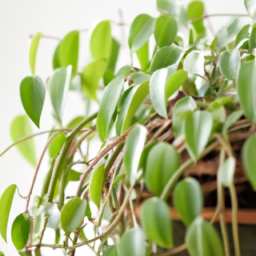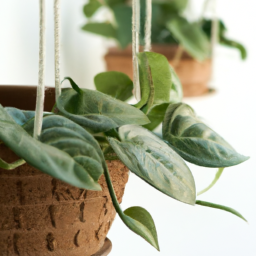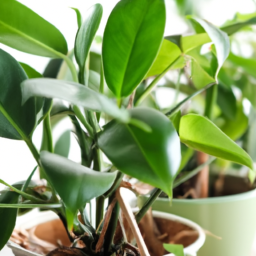
Are you looking to bring some greenery into your home but don’t have a lot of space to work with? Look no further than the world of window plants! These small, low-maintenance plants are perfect for adding a touch of nature to any room, no matter how limited your space may be. In this blog post, we’ll explore some of the best window plants that are sure to thrive in your home. Whether you’re a seasoned plant parent or a complete beginner, there’s a window plant out there for you. So let’s dive in and discover the perfect green companion for your windowsill!
Benefits of Growing Window Plants in Your Home
Improved Air Quality
Introduction
One of the key benefits of growing window plants in your home is the improved air quality they provide. Plants are natural air purifiers, absorbing carbon dioxide and releasing oxygen through the process of photosynthesis. This can help to reduce indoor air pollution and create a healthier living environment for you and your family.
How Plants Improve Air Quality
Plants also have the ability to remove toxins and pollutants from the air, such as formaldehyde, benzene, and trichloroethylene. This can help to reduce the risk of respiratory problems, allergies, and other health issues caused by poor indoor air quality. By placing plants near windows, where they can receive adequate sunlight and fresh air, you can maximize their air purifying benefits.
Best Plants for Improving Air Quality
Some of the best window plants for improving air quality include spider plants, peace lilies, snake plants, and pothos. These plants are known for their ability to filter out harmful toxins and pollutants, making them ideal choices for indoor spaces. By incorporating these plants into your home decor, you can enjoy cleaner, fresher air all year round.
Reduced Stress and Anxiety
Introduction
In addition to improving air quality, growing window plants in your home can also help to reduce stress and anxiety. Studies have shown that being around plants can have a calming effect on the mind and body, promoting relaxation and overall well-being. This can be especially beneficial in today’s fast-paced, high-stress world.
Plants as Natural Stress Relievers
The presence of plants in indoor spaces has been linked to lower levels of stress, anxiety, and depression. Their green foliage and natural textures can create a sense of tranquility and connection to nature, helping to create a more peaceful and harmonious environment. By placing plants near windows, where you can see them throughout the day, you can experience their stress-relieving benefits to the fullest.
Best Plants for Reducing Stress and Anxiety
Some of the best window plants for reducing stress and anxiety include lavender, aloe vera, jasmine, and English ivy. These plants are known for their soothing scents, calming properties, and aesthetic appeal. By incorporating these plants into your home decor, you can create a serene and relaxing atmosphere that promotes mental and emotional well-being.
Enhanced Aesthetic Appeal
Introduction
Another benefit of growing window plants in your home is the enhanced aesthetic appeal they provide. Plants can add color, texture, and life to indoor spaces, creating a more inviting and visually appealing environment. Whether you prefer lush green foliage, vibrant flowers, or unique succulents, there are window plants to suit every style and taste.
Plants as Decorative Accents
Plants can serve as natural decorations that bring a touch of nature indoors. They can be placed on windowsills, shelves, or hanging baskets to add visual interest and personality to any room. By choosing plants with different shapes, sizes, and colors, you can create a dynamic and eye-catching display that enhances the overall look of your home.
Best Plants for Aesthetic Appeal
Some of the best window plants for enhancing aesthetic appeal include orchids, succulents, ferns, and begonias. These plants are prized for their beauty, diversity, and versatility, making them popular choices for indoor gardening. By selecting plants that complement your decor and personal style, you can elevate the visual appeal of your home and create a welcoming and harmonious living space.

Top 10 Window Plants for Beginners
Choosing the Right Plants
When it comes to selecting the best window plants for beginners, there are a few key factors to consider. First and foremost, you’ll want to choose plants that are well-suited to the amount of sunlight your window receives. Some plants thrive in full sun, while others prefer more shade. Additionally, you’ll want to consider the size of your window and the amount of space you have available for your plants. Some plants, such as vine plants, can grow quite large and may not be suitable for smaller windows.
Another important factor to consider when choosing window plants is the amount of care and maintenance they require. As a beginner, you’ll want to start with plants that are relatively low-maintenance and easy to care for. Look for plants that are resilient and can tolerate a bit of neglect, such as succulents or spider plants. These types of plants are perfect for beginners who may not have a green thumb yet.
Lastly, consider the aesthetic appeal of the plants you choose. Window plants can add a pop of color and life to your space, so be sure to select plants that you find visually appealing. Consider the size, shape, and color of the leaves, as well as any flowers or blooms the plant may produce. Choose plants that complement your existing decor and bring a sense of beauty and tranquility to your space.
Caring for Your Window Plants
Once you’ve selected the perfect window plants for your space, it’s important to know how to care for them properly. Different plants have different care requirements, so be sure to research the specific needs of each plant you choose. However, there are some general tips that apply to most window plants.
First and foremost, be sure to water your plants regularly. Most plants prefer to be watered when the top inch of soil is dry to the touch, but be sure to research the specific watering needs of each plant you have. Overwatering can be just as harmful as underwatering, so be sure to strike the right balance.
In addition to watering, be sure to provide your window plants with the right amount of sunlight. Most plants prefer bright, indirect light, so be sure to place them near a sunny window where they can receive plenty of natural light. Be mindful of any drafts or temperature fluctuations near your window, as extreme temperatures can stress your plants.
Lastly, be sure to fertilize your window plants regularly to promote healthy growth. Choose a balanced, water-soluble fertilizer and follow the instructions on the packaging for best results. Regular fertilization will help your plants thrive and stay healthy for years to come.
Top 10 Window Plants for Beginners
1. Spider Plant – Spider plants are incredibly easy to care for and can thrive in a variety of conditions. They produce long, arching leaves and small white flowers, making them a beautiful addition to any window.
2. Pothos – Pothos plants are known for their trailing vines and heart-shaped leaves. They are extremely resilient and can tolerate low light conditions, making them perfect for beginners.
3. Snake Plant – Snake plants are incredibly low-maintenance and can thrive in low light conditions. They have tall, stiff leaves with striking patterns, making them a unique and visually appealing choice for your window.
4. Peace Lily – Peace lilies are known for their elegant white flowers and lush, dark green leaves. They thrive in low light conditions and are excellent air purifiers, making them a great choice for your window.
5. Succulents – Succulents come in a wide variety of shapes, sizes, and colors, making them a versatile choice for your window. They are extremely drought-tolerant and require minimal maintenance, making them perfect for beginners.
6. Aloe Vera – Aloe vera plants are not only beautiful, but they also have a variety of medicinal properties. They prefer bright, indirect light and well-draining soil, making them a great choice for your window.
7. ZZ Plant – ZZ plants are incredibly resilient and can thrive in low light conditions. They have glossy, dark green leaves that add a touch of elegance to any space, making them a great choice for beginners.
8. English Ivy – English ivy plants are known for their trailing vines and lush, green leaves. They prefer bright, indirect light and moist soil, making them a great choice for your window.
9. Jade Plant – Jade plants are known for their thick, fleshy leaves and tree-like appearance. They prefer bright, indirect light and well-draining soil, making them a great choice for beginners.
10. Rubber Plant – Rubber plants have large, glossy leaves that add a tropical touch to any space. They prefer bright, indirect light and regular watering, making them a great choice for your window.
In conclusion, choosing the best window plants for beginners is all about finding plants that are well-suited to your space, easy to care for, and visually appealing. By following these tips and selecting from our top 10 list of window plants, you can create a beautiful and thriving indoor garden that will bring joy and tranquility to your space. Happy planting!

How to Care for and Maintain the Best Window Plants
Choosing the Right Plants for Your Window
When selecting the best window plants for your home, it’s important to consider the amount of sunlight that your windows receive. Different plants have varying light requirements, so it’s essential to choose plants that will thrive in the specific conditions of your window.
Additionally, consider the size of your window and the space available for plants. Some plants, such as trailing vines or compact succulents, are perfect for smaller windowsills, while larger plants may require more space.
Lastly, think about your personal preferences and the aesthetic you want to achieve. Do you prefer flowering plants, foliage plants, or a mix of both? Choose plants that not only suit the light and space requirements of your window but also align with your style and taste.
Once you’ve selected the best window plants for your space, it’s important to properly care for them to ensure they thrive and continue to enhance your home’s ambiance.
Providing Adequate Light and Water
Light and water are essential for the health and growth of window plants. Most plants require at least a few hours of sunlight each day, so be sure to place your plants in a location where they will receive adequate light. If your window doesn’t get much sunlight, consider supplementing with a grow light to ensure your plants get the light they need.
When it comes to watering, it’s important to strike a balance. Overwatering can lead to root rot, while underwatering can cause plants to wilt and die. Check the soil moisture regularly and water your plants when the top inch of soil feels dry to the touch. Different plants have different water requirements, so be sure to research the specific needs of your plants and adjust your watering schedule accordingly.
In addition to light and water, proper humidity levels are also important for the health of your window plants. Most houseplants prefer humidity levels of around 40-60%, so consider using a humidifier or placing a tray of water near your plants to help maintain the ideal humidity levels.
Regular Maintenance and Pest Control
Regular maintenance is key to keeping your window plants healthy and thriving. This includes pruning dead or yellowing leaves, repotting when necessary, and fertilizing periodically to provide essential nutrients to your plants. Be sure to remove any debris or dead plant material from the soil to prevent pests and diseases from taking hold.
Speaking of pests, keeping an eye out for common houseplant pests such as spider mites, mealybugs, and aphids is essential for maintaining the health of your window plants. If you notice any signs of pest infestation, such as yellowing leaves, sticky residue, or webbing, take action immediately to prevent the pests from spreading to other plants.
By following these tips for caring for and maintaining the best window plants, you can create a beautiful and thriving indoor garden that enhances your home’s ambiance and brings a touch of nature indoors. Remember to tailor your care routine to the specific needs of your plants and enjoy watching them grow and flourish in your window.
Highlights of this article
Looking to bring a touch of nature into your home but don’t have a green thumb? Window plants are the perfect solution! These low-maintenance plants are not only easy to care for, but they also add a pop of color and life to any room. Whether you have a sunny south-facing window or a shady east-facing one, there is a window plant out there for you.
Some of the best window plants include succulents like aloe vera and jade plants, which thrive in bright, indirect light. Spider plants and pothos are great options for low-light areas, while herbs like basil and mint do well in sunny windowsills. No matter your space or lighting situation, there is a window plant that will brighten up your home and bring a little bit of the outdoors inside. So go ahead, pick out a few window plants and watch your space come to life!
Curious Minds Asked, We Responded. Frequently Asked Questions:
Q1: What are the best window plants for beginners?
A1: If you’re new to gardening, some easy-to-care-for window plants include spider plants, pothos, and succulents. These plants require minimal maintenance and can thrive in various lighting conditions.
Q2: How can I choose window plants that thrive in low light?
A2: For low-light conditions, consider plants like peace lilies, snake plants, and ZZ plants. These plants are known for their ability to thrive in environments with limited natural light.
Q3: What are some window plants that can help improve indoor air quality?
A3: Plants such as aloe vera, English ivy, and peace lilies are known for their air-purifying properties. These plants can help remove toxins from the air and create a healthier indoor environment.
Q4: How often should I water my window plants?
A4: The frequency of watering will depend on the specific plant and its individual needs. In general, it’s important to check the soil moisture before watering and ensure that the plant’s roots are not sitting in water to prevent overwatering.
Q5: Can I grow herbs in my windowsill?
A5: Yes, herbs like basil, mint, and parsley can thrive in a sunny windowsill. Make sure to provide them with enough sunlight and well-draining soil, and you’ll have fresh herbs at your fingertips for cooking.
Dr. Olivia Green is a botanist with over two decades of experience in indoor plant cultivation. She holds a Ph.D. in Plant Biology and has dedicated her career to researching plant behavior in controlled environments. Dr. Green is passionate about helping plant enthusiasts master the art of indoor gardening through her extensive knowledge and practical insights.


